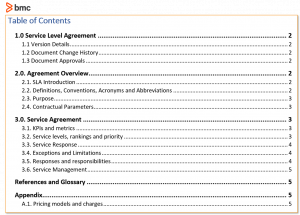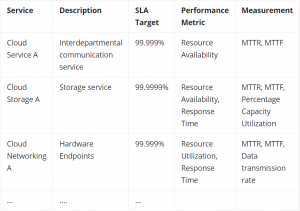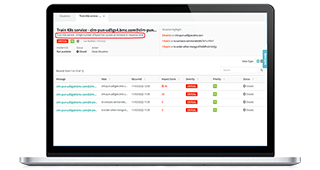

Most service providers understand the need for service level agreements (SLAs) with their partners and customers. But creating one might feel daunting because you don’t know where to start or what to include. In this article, we share some SLA examples and templates to help you create SLAs.
An SLA is a documented agreement between a service provider and a customer that defines: (i) the level of service a customer should expect, while laying out the metrics by which service is measured, as well as (ii) remedies or penalties should agreed-upon service levels not be achieved. It is a critical component of any technology vendor contract.
Before subscribing to an IT service, the SLA should be carefully evaluated and designed to realize maximum service value from an end-user and business perspective. Service providers should pay attention to the differences between internal outputs and customer-facing outcomes, as these can help define the service expectations.
Let’s examine a sample SLA that you can use as a template for creating your own SLAs. Remember that these documents are flexible and unique. Make changes as necessary, and ensure that you correctly identify and include the relevant parties. Also, consider additional topics that you may want to add to your agreement(s) to enhance them, such as:
There are several ways to write an SLA. Below is a mock table of contents that you can leverage to start writing your own SLAs.

Now, I’ll break down each section with a few details and examples.
The first page of your document is simple, yet important. It should include:
| Document details & change history | |||
| Version | Date | Description | Authorization |
| … | … | … | … |
| Document approvals | |||
| Name | Role | Signature | Date |
| … | … | … | … |
Last Review: MM/DD/YYYY
Next Scheduled Review: MM/DD/YYYY
In the next section, the agreement overview should include four components:
Include a brief introduction of the agreement, relevant parties, service scope, and contract duration. For instance:
This is a Service Level Agreement (SLA) between [Customer] and [Service Provider]. This document identifies the services required and the expected level of services between MM/DD/YYYY to MM/DD/YYYY.
Subject to review and renewal scheduled by MM/DD/YYYY.
Include a definition and brief description of terms used to represent services, roles, metrics, scope, parameters, and other contractual details that may be interpreted subjectively in different contexts. This information may also be distributed across appropriate sections of this document instead of collated into a single section.
| Term | Description |
| SLA | Service Level Agreement |
| Accuracy | Degree of conformance between a result specification and standard value. |
| Timeliness | The characteristic representing performance of action that leaves sufficient time remaining to maintain SLA service expectation. |
| IT Operations Department | A business unit of [Customer] responsible for internal IT operations. |
| … | … |
This section defines the goals of this agreement, such as:
The purpose of this SLA is to specify the requirements of the software-as-a-service (SaaS) solution as defined herein with regards to:
In this section, you’ll want to define the policies and scope of this contract related to application, renewal, modification, exclusion, limitations, and termination of the agreement.
This section specifies the contractual parameters of this agreement:
This section can include a variety of components and subsections, including:
Key performance indicators (KPIs) and other related metrics can and should support your SLA, but the achievement of these alone does not necessarily result in the desired outcome for the customer.
| Metric | Commitment | Measurement |
| Availability | MTTR (mean time to repair) | |
| Reliability | MTTF (mean time to failure) | |
| Issue Recurrence | ||
| … | … | … |
| Severity Level | Description | Target Response |
| 1. Outage | SaaS server down | Immediate |
| 2. Critical | High risk of server downtime | Within 10 minutes |
| 3. Urgent | End-user impact initiated | Within 20 minutes |
| 4. Important | Potential for performance impact if not addressed | Within 30 minutes |
| 5. Monitor | Issue addressed but potentially impactful in the future | Within one business day |
| 6. Informational | Inquiry for information | Within 48 hours |
| … | … | … |

Include any exceptions to the SLA conditions, scope, and application, such as:
This SLA is subject to the following exceptions and special conditions:
Here, you’ll define the responsibilities of both the service provider and the customer.
[Service Provider] responsibilities
Include service management and support details applicable to the service provider in this section.
Service coverage by the [Service Provider] as outlined in this agreement follows the schedule specified below:
Include reference agreements, policy documents, glossary, and relevant details in this section. This might include terms and conditions for both the service provider and the customer, and any additional reference material, such as third-party vendor contracts.
The appendix is a good place to include relevant information that doesn’t seem to fit elsewhere, such as pricing models and charges. The following section is an example of information that you may want to append to your SLA.
Include the pricing models for each service type with detailed specifications.
| Service | Capacity | Type – Throughput | Price |
| Cloud Storage A | |||
| Option | |||
| A | 500GB | HDD – 250 MB/s | $5.00/Mo |
| B | 10TB | SSD – 500 MB/s | $10.00/Mo |
| C | 50TB | SSD – 1000 MB/s | $15.00/Mo |
| Additional Storage | |||
| A.1 | 100GB | HDD – 250 MB/s | $1.00/Mo |
| B.1 | 2TB | SSD – 500 MB/s | $2.00/Mo |
| C.1 | 10TB | SSD – 1000 MB/s | $4.00/Mo |
| … | … | … | … |
Though your SLA is intended to be a legally binding agreement, it doesn’t need to be incredibly lengthy or overly complicated. It can further be a malleable document that is improved upon over time, with the consent of all relevant parties. Our advice: Begin building an SLA using the template above and the examples found herein and consult with your customers for any perceived gaps. As unforeseen circumstances are often inevitable, you can always revisit and tweak the SLA, if needed.
Additional SLA templates and examples are available here:
Learn how HelixGPT brings generative AI to life throughout the BMC Helix platform

These postings are my own and do not necessarily represent BMC's position, strategies, or opinion.
See an error or have a suggestion? Please let us know by emailing blogs@bmc.com.
BMC works with 86% of the Forbes Global 50 and customers and partners around the world to create their future. With our history of innovation, industry-leading automation, operations, and service management solutions, combined with unmatched flexibility, we help organizations free up time and space to become an Autonomous Digital Enterprise that conquers the opportunities ahead.
Learn more about BMC ›
Muhammad Raza is a Stockholm-based technology consultant working with leading startups and Fortune 500 firms on thought leadership branding projects across DevOps, Cloud, Security and IoT.